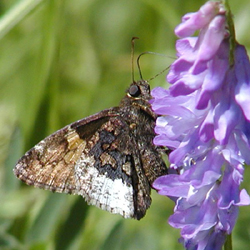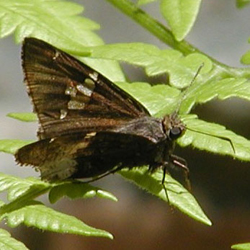Find a Butterfly
Hoary Edge
Achalarus lyciades
Named
Geyer, 1832

Identification
Wingspan 1 1/2-1 3/4". Closely resembles Silver-spotted Skipper above, but may be easily recognized by pattern of hindwing below, with large whitish patch (or "hoary edge") on outer portion of wing. The more rounded hindwings lack the bright silver spot of the Silver-spotted Skipper.
Distribution
Southeastern Minnesota east to southern New Hampshire and south through the United States to eastern Texas and northern Florida. In New England, largely limited to three southern states, with a few records from southern New Hampshire.
Status in Massachusetts
Both Scudder and Holland (1931) called the Hoary Edge rare in southern New England. Macy and Shepard (1941) remarked that "numerous specimens have been taken from Waltham, Massachusetts." During the Atlas period, the species was reported uncommonly in a swath from northeast to south central Massachusetts with no records from western, north central, most of southeastern Massachusetts, or Cape Ann, though many of the areas where it was unrecorded were well covered during the Atlas. Usually found singly. Maximum: 5 at Broad Meadow Brook WLS, Worcester (Worcester Co.), 15 June 1991 (T. Dodd).

Flight Period in Massachusetts
Single-brooded, with adults from early June to late July. Scudder wrote that the species "...rarely (flew) before the first of June about Boston...," but gave no exact early dates. Extremes: 6 June 1991, Franklin (Norfolk Co.), B. Cassie and L. Lovell and 8 August 1991, Woburn (Middlesex Co.), R. Walton.
Larval Food Plants
Beggar‘s Tick, Bush Clover (Lespedeza, sp.), and False Indigo (Baptisia, sp.) are most widely utilized. Dodd has found Hoary Edge ovipositing on Tick-Trefoil (Desmodium paniculatum) and Round-headed Bush Clover (Lespedeza capitata) in Massachusetts.
Adult Food sources
Found nectaring on 6 species by Atlas workers. Dogbane and Common Milkweed flowers are most often visited. In addition to these species, New Jersey Tea, Black-eyed Susan, clovers, and several other flowers are visited with less frequency.

Habitat
Open areas, including meadows and roadsides, as well as nearby woodland edges.
Life Cycle
EGG: Off-white; dome-shaped and reticulated. OVIPOSITION: Eggs laid singly, on the underside of host plant leaflets. LARVA: Dark green, with blue-green stripes along the back and yellow-orange stripes laterally. The body is speckled yellow-orange and the head is black. CHRYSALIS: Pale brown, with scattered patches of black dots. OVERWINTERING STAGE: The species overwinters as a pupa. Adults emerge from the chrysalis in early summer. Males establish territories, perching within six feet of the ground at woodland openings and edges. Larvae construct a nest in the same manner as the Silver-spotted Skipper, silking together overlapping leaves of the food plant. Scudder said, "It repeatedly changes its home, quitting it the moment it becomes too strait and constructing another, often crawling some distance, as to a contiguous plant, to make a good selection."
Account Author
Brian Cassie
Additional Information
Read more on this species at the North American Butterfly Association.



